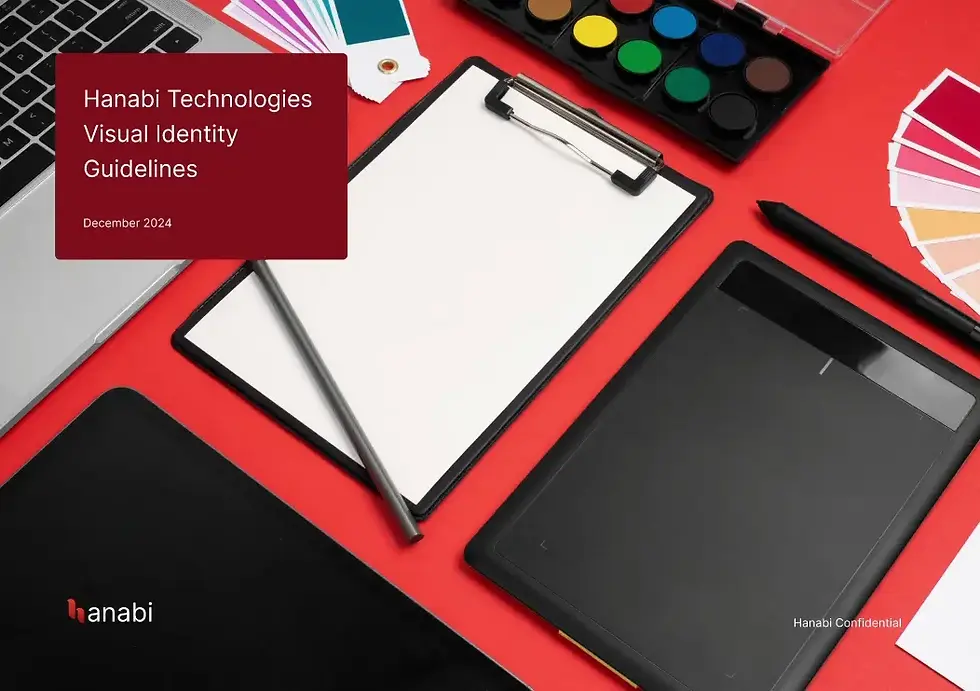Hanabi Brand Enhancement
As the Product Designer at Hanabi Technologies, I led a comprehensive brand enhancement initiative that elevated Hanabi’s digital presence, unified its visual identity, and positioned our flagship AI product, Hana, as a leader in the Google Workspace ecosystem. This transformation was achieved through a strategic blend of product thinking, cross-functional collaboration, and executional excellence—core competencies expected of an Associate Product Manager.

1. Hanabi Website Revamp: Showcasing Expertise and Innovation

Objective:
-
Redesign www.hanabitech.com to reflect Hanabi’s expertise in software development, AI, and digital transformation.
Execution:
-
Developed a new information architecture to clearly present Hanabi’s core services: web, mobile, desktop development, and AI chatbot solutions.
-
Dedicated sections for our flagship product (Hana by Hanabi), technology stack (React, Next.js, Node.js, TypeScript, OpenAI, GCP, AWS), and case studies.
-
Created a “Blogs & Insights” hub to share thought leadership on AI, product design, and tech trends.
-
Enhanced user experience with responsive layouts, clear CTAs, and a streamlined navigation system.
Outcome:
-
Improved brand perception, increased website engagement, and provided a clear, conversion-focused journey for prospective clients and partners.
2. Brand Visual Identity & Consistency

Objective:
-
Unify Hanabi’s brand across all touchpoints for recognition and trust.
Execution:
-
Created a comprehensive brand visual identity document covering logo usage, color palette (Material Theme Builder-based), typography (Inter), illustration style, and grid/layout systems.
-
Standardized marketing and product assets for digital and print.
-
Ensured accessibility and scalability across platforms.
Outcome:
-
Achieved a cohesive, professional brand image, supporting both marketing and product teams.
1. Aligning Design with Business Goals
-
I learned that great design isn’t just about aesthetics or usability—it must directly support business objectives. Every user flow, feature, and visual decision was made with Hana’s growth, user engagement, and market differentiation in mind.
-
I became comfortable interpreting business metrics and using them to prioritize design and feature work.
2. Data-Driven Decision Making
-
I started using analytics and user feedback to inform product improvements, not just design tweaks. Understanding how to measure product success and interpret user data became second nature.
-
I realized the importance of validating assumptions through real user insights and iterating quickly based on evidence.
3. Cross-Functional Collaboration
-
Working closely with developers, the CEO/PM, and marketing, I learned how to communicate requirements, negotiate trade-offs, and keep everyone aligned on priorities.
-
I developed empathy for engineering and business constraints, and learned to advocate for users while balancing technical feasibility and timelines.
4. Strategic & Systems Thinking
-
Transitioning from a feature-focused mindset to thinking about the entire product ecosystem was a key shift. I started considering the long-term scalability of design systems, the impact of new modules, and how each decision fits into Hana’s broader roadmap.
-
I became adept at breaking down complex problems into actionable steps and mapping dependencies across teams.
5. Ownership & Accountability
-
As the lone designer, I owned not just the UI/UX, but also branding, marketing content, documentation, and even community engagement. This taught me to take full responsibility for outcomes, not just deliverables.
-
I learned to set clear goals, track progress, and pivot quickly when priorities changed.
6. User-Centric Mindset
-
My design background made me naturally empathetic to user needs, but building Hana taught me to validate those needs through research and ongoing feedback loops.
-
I learned to balance user delight with business value and technical constraints.
7. Communication & Storytelling
-
Crafting product narratives for landing pages, pitch decks, and community channels taught me the power of clear, persuasive communication. I learned to tailor my message for different audiences - users, stakeholders, and potential investors.
8. Adaptability in a Startup Environment
-
I became comfortable wearing multiple hats, shifting between design, product, marketing, and support as needed. This adaptability is crucial for product managers in early-stage companies.
8. Adaptability in a Startup Environment
-
I became comfortable wearing multiple hats, shifting between design, product, marketing, and support as needed. This adaptability is crucial for product managers in early-stage companies.
3. Marketing Assets & Campaigns
Objective:
-
Drive lead generation and awareness through digital marketing.
Execution:
-
Designed Google Ads creatives, social media banners, and email templates aligned with the new brand identity.
-
Implemented A/B testing for ad creatives to optimize conversion rates.
-
Supported product launches with tailored campaign assets.
Outcome:
-
Increased inbound leads and improved campaign ROI.




4. Conversation AI: Website Chatbot Implementation

Objective:
-
Enhance customer engagement and automate support on Hanabi website.
Execution:
-
Designed and deployed a custom chatbot, leveraging Hanabi’s AI expertise, to answer FAQs, qualify leads, and guide users to relevant resources.
-
Integrated chatbot analytics to track user interactions and optimize flows.
Outcome:
-
Reduced support workload and improved user satisfaction.

